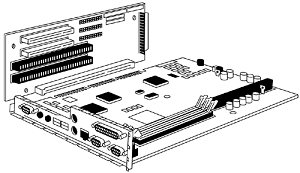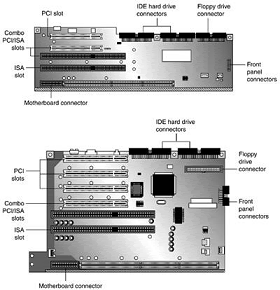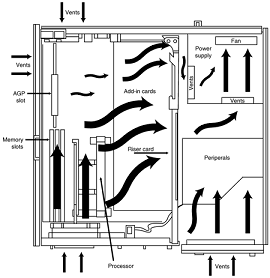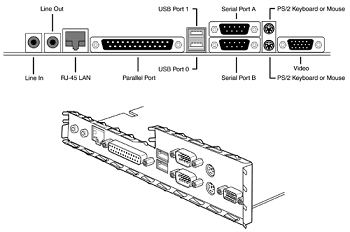NLX MotherboardNLX Motherboard
NLX is a low-profile form factor designed to replace the nonstandard LPX design used in previous low-profile systems. First introduced in November 1996 by Intel, NLX was a popular form factor in the late 1990s for Slimline corporate desktop systems from vendors such as Compaq, HP, Toshiba, and others.
Since 2000, many Slimline systems have used variations on the flex-ATX motherboard instead. NLX is similar in initial appearance to LPX, but with numerous improvements designed to enable full integration of the latest technologies.
NLX is basically an improved version of the proprietary LPX design, but, unlike LPX, NLX is fully standardized, which means you should be able to replace one NLX board with another from a different manufacturer—something that was not possible with LPX.
Another limitation of LPX boards is the difficulty in handling the larger physical size of the newer processors and their larger heatsinks, as well as newer bus structures such as AGP for video. The NLX form factor has been designed specifically to address these problems. In fact, NLX provides enough room for some vendors to support dual Slot 1 Pentium III processors in this form factor.

The main characteristic of an NLX system is that the motherboard plugs into the riser, unlike LPX where the riser plugs into the motherboard. Therefore, the motherboard can be removed from the system without disturbing the riser or any of the expansion cards plugged into it.
In addition, the motherboard in a typical NLX system literally has no internal cables or connectors attached to it! All devices that normally plug into the motherboard—such as drive cables, the power supply, the front panel light, switch connectors, and so on—plug into the riser instead (see Figure above).
By using the riser card as a connector concentration point, you can remove the lid on an NLX system and literally slide the motherboard out the left side of the system without unplugging a single cable or connector on the inside. This allows for unbelievably quick motherboard changes.
As Figure below shows, by using different sizes and types of riser cards, a system designer can customize the features of a given NLX system.

Such a design is a boon for the corporate market, where ease and swiftness of servicing is a major feature. Not only can components be replaced with lightning speed, but because of the industry-standard design, motherboards, power supplies, and other components can be interchanged even among different systems.
Specific advantages of the NLX form factor include:
-
Support for all desktop system processor technologies. This is especially important because, since the NLX form factor was developed, both AMD and Intel adopted and then abandoned bulkier slot-based processors and returned to more compact socketed processors. NLX can handle both types of processors.
-
Flexibility in the face of rapidly changing processor technologies. Backplane-like flexibility has been built in to the form by allowing a new motherboard to be easily and quickly installed without tearing your entire system to pieces. But unlike traditional backplane systems, many industry leaders, such as Compaq, Toshiba, and HP, have sold NLX-based systems.
-
Support for newer technologies. This includes Accelerated Graphics Port (AGP) high-performance graphic solutions, Universal Serial Bus (USB), and memory modules in DIMM or RIMM form.
-
Ease and speed of servicing and repair. Compared to other industry-standard interchangeable form factors, NLX systems are by far the easiest to work on and allow component swaps or other servicing in the shortest amount of time.
Furthermore, with the importance of multimedia applications, connectivity support for such things as video playback, enhanced graphics, and extended audio has been built in to the motherboard.
This should represent a good cost savings over expensive daughterboard arrangements that have been necessary for many advanced multimedia uses in the past. Although ATX also has this support, LPX and Baby-AT don't have the room for these additional connectors. Figure below shows the basic NLX system layout.

Notice that, similar to ATX, the motherboard is clear of the drive bays and other chassis-mounted components. Also, the motherboard and I/O cards (which, like the LPX form factor, are mounted parallel to the motherboard) can easily be slid in to and out of the side of the chassis, leaving the riser card and other cards in place. The processor can be easily accessed and enjoys greater cooling than in a more closed-in layout.
Most NLX motherboards use chipset-integrated or motherboard-based video instead of a separate AGP card, but you must remove an AGP card installed in an NLX system before you can remove the motherboard for servicing. Also, the AGP card used in an NLX system must have a different form factor to enable it to clear the rear connector shield at the back of the NLX motherboard.
As with most of the form factors, you can identify NLX via the unique I/O shield or connector area at the back of the board. You only need a quick look at the rear of any given system to determine which type of board is contained within. Figure 4.23 shows the unique stepped design of the NLX I/O connector area.

This allows for a row of connectors all along the bottom and has room for double-stacked connectors on one side. As you can see, the NLX form factor has been designed for maximum flexibility and space efficiency.
Even extremely long I/O cards will fit easily without getting in the way of other system components—a problem with Baby-AT form factor systems. The specification and related information about the NLX form factor are available at the Desktop Form Factor site.
Although NLX is a standard form factor—just as the ATX family is—most NLX products have been sold as part of complete systems aimed at the corporate market. Very few aftermarket motherboards have been developed in this form factor.
Thus, although NLX makes swapping motherboards easy, you are more likely to encounter it in a corporate environment than in a home or small-business computer. The micro-ATX and flex-ATX form factors have largely superseded NLX in the markets formerly dominated by LPX.
Overall, one of the ATX variants is still the best choice for most new systems where expandability, upgradeability, low cost, and ease of service are of prime importance.